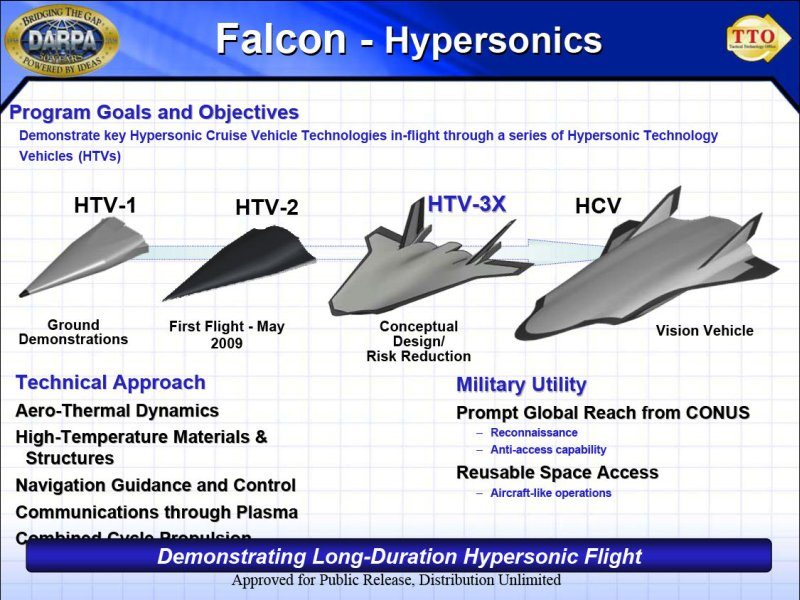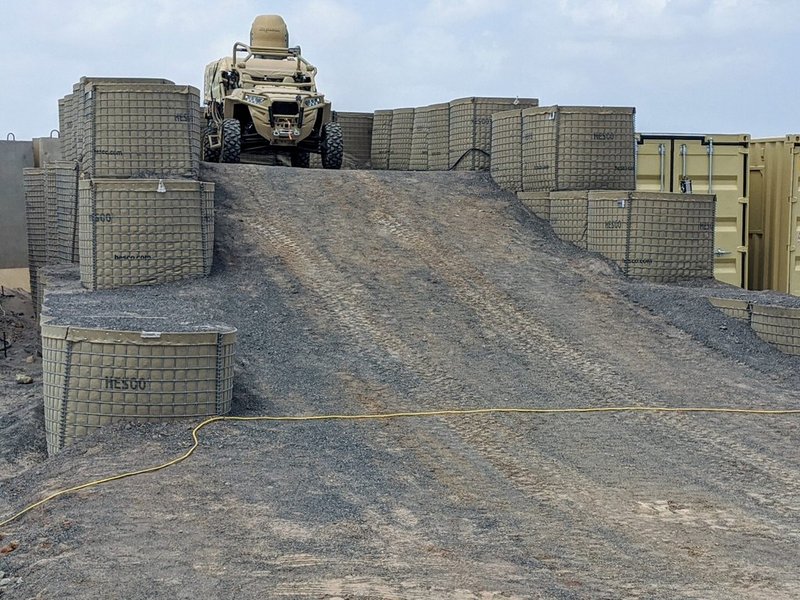
Additional sensors, also capable of helo deployment to site, can also provide EW beyond the organic EO/IR sensors of the HEL system itself.
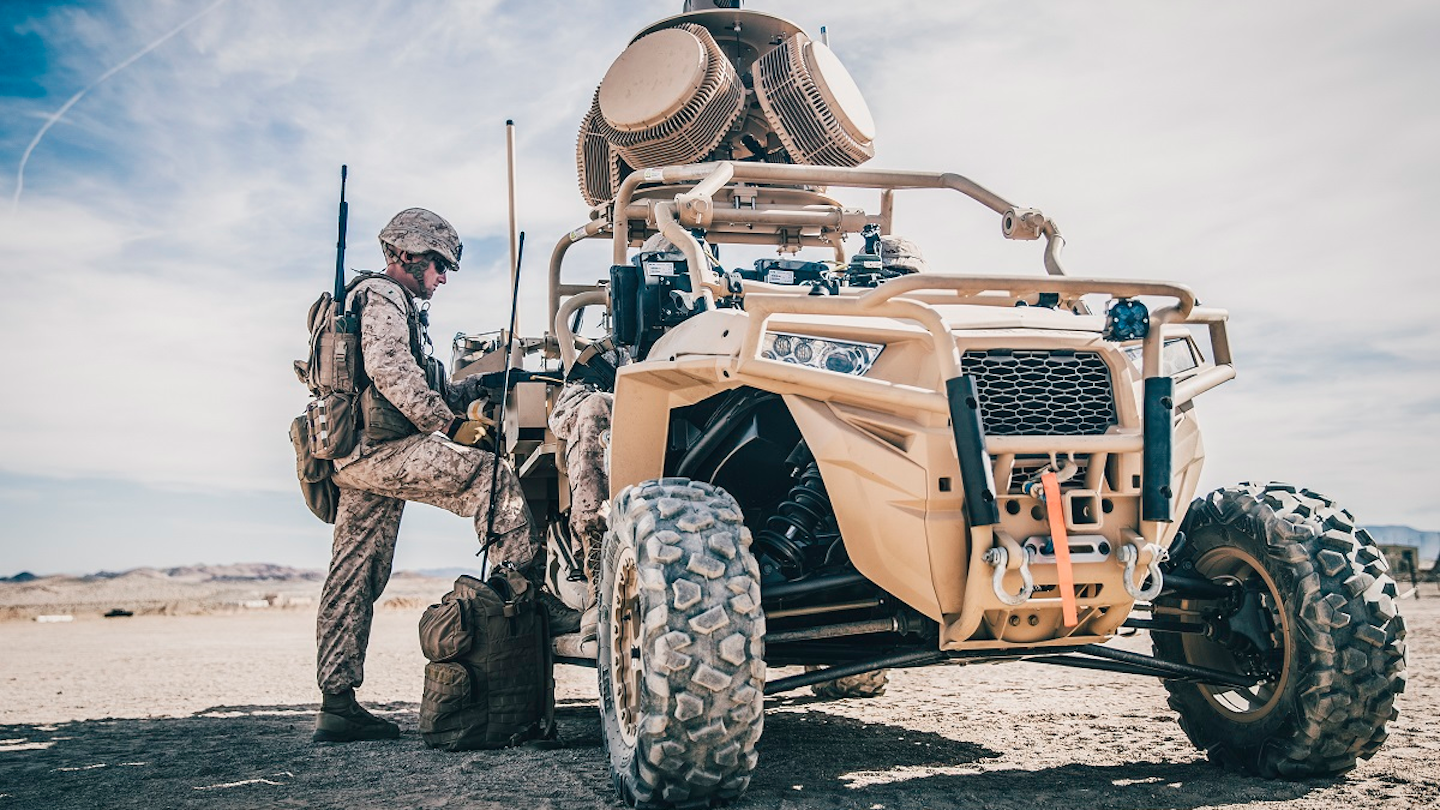


The Army and Lockheed Martin are preparing for the first test firing of the extended-range version of the Guided Multiple Launch Rocket System (GMLRS), which will double the rocket’s reach.
The goal is get the current GMLRS rocket out to 150-plus kilometers, Gaylia Campbell, Lockheed Martin’s vice president of precisions fires and combat maneuver systems, told Defense News in an interview leading up to the Association of the U.S. Army’s virtual conference.
The flight test is expected in mid-November at White Sands Missile Range, New Mexico, and will be the first of several engineering and manufacturing development-phase tests ahead of a production decision.
“GMLRS is kind of the backbone of the field artillery” and it’s a cost effective way for the Army and its allies with the system to have more flexibility when it comes to reach, Campbell said. “If you think about certain regions of the world, like Poland and Romania, and the reach that a 75-kilometer distance away system gives them today and being able to take that to 150 kilometers gives them a lot more flexibility in how they operate and where they position their forces,” she said.
The design to extend the range of GMLRS includes a modernized pod expected to improve reload operations, which will still contain six rounds per pod, Campbell said. The pod will be able to accommodate both legacy and extended-range rockets.
The GMLRS rounds come in two variants: the Guided Unitary and the Guided Alternative Warhead.
The new pods and the extended-range GMLRS will be compatible with the High Mobility Artillery Rocket System and MLRS M270 launchers, Campbell said.
To double the range of the system, Lockheed used advances in technologies and a “slightly” increased rocket motor size. “We’re doing a tail-driven guidance as well,” she noted.The Army and Lockheed will continue a test campaign through fiscal 2021 with a goal of getting into production beginning in early FY22, Campbell said.
Lockheed is planning to produce the new extended-range rockets at its Camden, Arkansas, facility.
According to a company statement, Lockheed has produced more than 45,000 GMLRS rounds and is under contract to provide another 9,000 GMLRS Unitary and AW rockets as well as over 300 Low-Cost- Reduced-Range Practice Rockets for both U.S. Army and international customers.
2) The US Army Secretary just hinted at some of the accuracy measurements in early hypersonic testing (LRHW program). The exact quote was posted by Steve Trimble of AvWeek -The hypersonic ARRW will likely be the first operational hypersonic weapon in the U.S. inventory. Gebara said the B-52 would be able to carry two ARRWs on each of its two wing pylons. Little has been revealed about the ARRW, which uses a booster rocket to accelerate to hypersonic speed, then glides to impact.
“This thing is going to be able to go, in 10-12 minutes, almost 1,000 miles,” Gebara said. “It’s amazing.”
LINK
It really isn't inside a year as an effort (though it may be as a project). The need to identify and build demonstrator aircrafts (yes multiple) was presented in a couple of Obama's budgets and the program related work probably goes back even longer. More specifically, the Obama administration shared this plan in early 2015 as part of the FY16 budget request which kick started this effort in all earnest (i.e. build one demonstrator -> prototype each for the USAF and USN 6th gen need). The adaptive engine programs go back about a decade, if not slightly longer, so that should have been a sign that other areas are also being looked at as there is only so much you can do with engine tech without having a good idea of what sort of propulsion demands you are going to need. It needs a cross-disciplinary approach.kit wrote:Would Brar be able to describe how the US was able to prototype and build a 6th generation fighter inside a year ? A revolution itself in the lead time required. Hopefully it could lead to a complete revolution in the aviation sector.
Yes it could. But like any high-risk/high-payoff strategy, it has to go through its paces and survive the challenges of developing something that is going to be this cutting edge at pace. So this is definitely one of the highest risk programs in the Pentagon right now, not too different to what ATF wanted to achieve back in the 1980's when it was stood up (fly a 5th generation demonstrator with prototype 5G engines by 1990). Probably not at the level of requiring "a miracle a day" a la B-2 but still probably quite cutting edge and thus high risk by any standard.kit wrote: Hopefully it could lead to a complete revolution in the aviation sector.
It is a DSCA (US State Deptt) notification to congress. It does not constitute a contractual offering, or a commitment to buy. This is needed to be approved before the F-35 program office formally submits a bid for the Finnish fighter replacement program. It is more comprehensive than what Finland will end up getting. And it will not cost this much. I think the program cap is $10 Bn. Usually with DSCA what is approved is more comprehensive than what is eventually contracted. This is down primarily because the bidders want more things approved since they don't want to go back with another notification process in case customer demands change, and because the State Deptt is usually fairly mediocre when it comes to estimated weapon costs for yet to be negotiated packages.Philip wrote:Finland to buy 64 JSFs for $12.5B.
October 12/20: Finland The US State Department approved external link a $12.5 billion purchase on Friday by Finland for 64 F-35 fighter planes and associated munitions and equipment.
Here is a video that I had been trying to dig up for a while. It was posted by one of the AvWeek journos a while back and describes how the funding for demonstrators and prototypes was put into the 2016 defense budget. So they've been lining up all these elements for quite a while -brar_w wrote:It really isn't inside a year as an effort (though it may be as a project). The need to identify and build demonstrator aircrafts (yes multiple) was presented in a couple of Obama's budgets and the program related work probably goes back even longer. More specifically, the Obama administration shared this plan in early 2015 as part of the FY16 budget request which kick started this effort in all earnest (i.e. build one demonstrator -> prototype each for the USAF and USN 6th gen need)....kit wrote:Would Brar be able to describe how the US was able to prototype and build a 6th generation fighter inside a year ? A revolution itself in the lead time required. Hopefully it could lead to a complete revolution in the aviation sector.
The technology gestation period is unlikely to be significantly compressed. They've been at it practically since 2010 so a 2030 LRIP will still mean 20 year of direct and indirect technology development.kit wrote:Thank you Brar ., i am curious about the technology enablers that actually let the gestation period to be much shorter than anyone expected., is there any open source info on that , the digital engineering term has been bandied about but what ?
The Fifth Generation Aerial Target will take its first flight later this month at Dugway Proving Ground, Utah, following nearly flawless completion of ground-based testing in September.
After a multi-month delay due to COVID-19 travel restrictions, 5GAT finished a battery of ground test events at Michael Army Airfield on September 18. Executed by an integrated team of Defense Department personnel and contractors, the testing verified complete aircraft control, safety procedures and key performance milestones for takeoff and landing. The single prototype executed 24 taxi test events (15 low-speed and nine high-speed) in just six days, with no interruptions or major problems.
The office of the director, operational test and evaluation sponsors the 5GAT, which is a full-scale, low-observable air vehicle that represents, more accurately than anything else available, the fifth-generation fighter aircraft threats U.S. forces could face. The low-cost drone is designed to enable air-to-air and surface-to-air platform and weapons test and evaluation, pilot and ground-force training, and the development of tactics, techniques and procedures against a fifth-generation threat.
"To determine whether a system really is combat-credible, we must test it under realistic conditions. That includes putting it up against a realistic threat," Robert Behler, the director, operational test and evaluation said. "Right now, we lack a test platform that truly represents fifth-generation air capabilities. Filling that gap as soon as possible is absolutely essential to both testing and training."
Sierra Technical Services, the prime contractor, has taken an innovative approach to building 5GAT, constructing the airframe from composites using soft tooling to reduce cost. The subcontractor, Fast Optimal Engineering, designed major subsystem solutions, including flight control actuation, electrical power, hydraulics, landing gear and steering. The subcontractor, 5D Systems, was responsible for developing the unmanned 5GAT's complex suite of software. 5GAT utilizes engines and other elements harvested from decommissioned DOD military aircraft, as well as an existing U.S. Army ground-based aircraft control system.
"With 5GAT, we've reinvented the typical acquisition process, and have aggressively used innovative program management and contracting processes to accelerate new capability development and ensure cost savings," Michael Crisp, a retired naval aviator and DOT&E's deputy director for air warfare said. "We pulled in expertise from ‘greybeards,' both industry and military, and the vision of our next generation of pilots, U.S. Air Force Academy cadets. We gave STS the freedom to explore cutting-edge design and manufacturing techniques, and got an even bigger bang for the taxpayer buck by recycling government-owned assets."
Flight testing will begin in late October. Initial flight test objectives include demonstrating 5GAT flight characteristics, various subsystems' performance and the aircraft's auto-takeoff and auto-landing functionality. Subsequent flight tests will progressively expand the aircraft's flight envelope in altitude, speed and greater G-force loading.
"When this unique prototype takes to the air in a few days, we will have gone from a basic concept to first flight in less than three-and-a-half years. That includes periods when the program slowed dramatically due to funding issues and the recent COVID-related delays," Crisp said. "I think 5GAT shows the power, creativity and flexibility that a small but diverse team with few constraints can produce — all to the benefit of the warfighter."

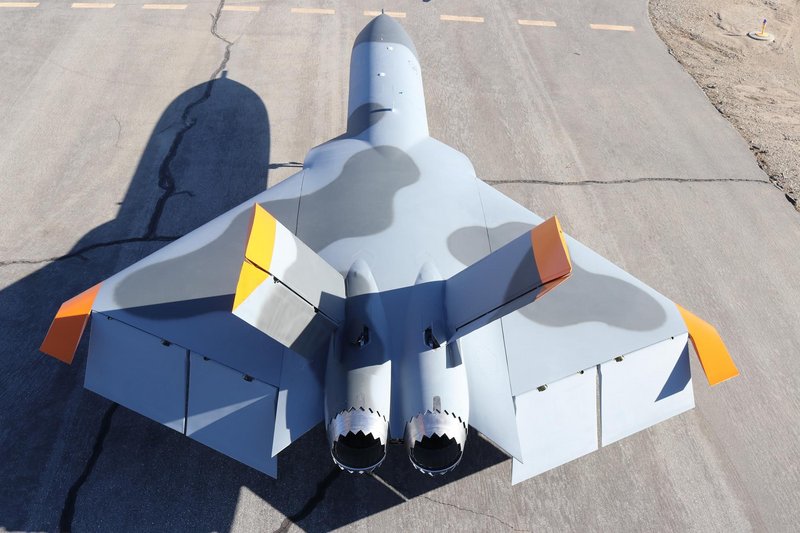
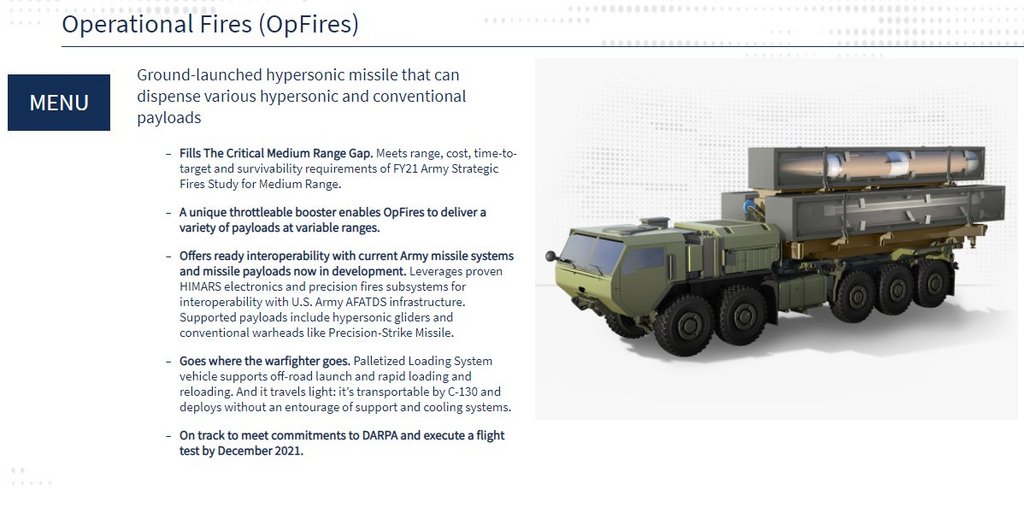
As Lockheed Martin (NYSE: LMT) continues the work with the Defense Advanced Research Projects Agency (DARPA) to advance the unique hypersonic technologies of its Operational Fires (OpFires) program, the company today announced its initial round of key subcontractors on the program. OpFires seeks to develop and demonstrate an innovative ground-launched system to enable a hypersonic boost glide missile system to penetrate modern enemy air defenses and rapidly engage time-sensitive targets.
Joining prime contractor Lockheed Martin on the OpFires Phase Three Weapon System Integration program are Northrop Grumman, Dynetics, and Electronic Concepts & Engineering, Inc (ECE).
“The engineering innovation required to deliver this maneuverable and rapid-response solution demands a best-of-industry team,” said Steven Botwinik, director of Tactical and Strike Missiles Advanced Programs. “OpFires and its unique throttleable booster make it a versatile platform to launch a variety of payloads over varied ranges and for this reason, OpFires is well-suited to address the Army’s Medium Range Strategic Fires needs.” LINK
Northrop Grumman completed the System Requirements Review for the Air Force Research Laboratory (AFRL) Aether Spy next-generation multifunction radar program.
With SRR completion, the company is now moving into the design phase of the program.
Aether Spy advances multifunction wideband digital Active Electronically Scanned Array (AESA) technology based on the advanced microelectronics created on the DARPA Arrays on Commercial Timescales (ACT) program. It will develop the next generation of integrated circuits that include additional processing and key design features that enable the Department of Defense trusted microelectronics strategy. The advanced devices will be fabricated and integrated into an advanced digital AESA to demonstrate a multifunction system capable of simultaneously performing multiple sensing, communication and electronic warfare functions.
“We look forward to demonstrating how the advanced digital AESA technology enables unmatched system agility that will meet the challenging mission requirements of advanced platforms,” said William Phillips, director, multifunction systems, Northrop Grumman. “The advanced integrated circuits, digital AESA architecture and multifunction software developed on Aether Spy will become foundational building blocks for the next generation of multifunction radio frequency (RF) systems supporting the future mission needs of the DoD.”
“This transition of digital AESA technology aligns well with the Air Force’s digital engineering initiatives,” said Thomas Dalrymple, technical advisor for Sensor Subsystems at the AFRL Sensors Directorate. “Aether Spy will enable significant improvements in surveillance and battle management missions in the future battlespace. The multifunction aspects are enabled by both software and hardware reprogrammability that will ensure this sensor will have operational impact for years to come.”
The program officially entered its Phase-3 earlier this year which will finally culminate in a AUR flight test next year -Lockheed Martin has selected three more suppliers for the Operational Fires (OpFires) hypersonic missile that seeks to demonstrate the first throttleable solid rocket motor. Northrop Grumman will...
Since 2018, OpFires has made impressive strides developing and demonstrating advanced booster technologies that had never been used in prior systems. Phase 1 and 2 performers Aerojet Rocketdyne, Exquadrum, and Sierra Nevada Corporation continue work towards throttle-able upper stage rocket motors suitable for tactical transport, storage, and engagement.
“The objective of DARPA’s OpFires program is to deliver an intermediate-range surface-to-surface missile in line with the Department of Defense’s push to field hypersonic platforms,” said Army Maj. Amber Walker, the DARPA program manager for OpFires.
The latest milestone of the OpFires program came amid the report that Army will no longer provide funding for OpFires integration work. DARPA announced that it will continue pressing forward with Phase 3 activities to “further advance the program goals of affordability and mobility for U.S. and Allied forward forces”.
“DARPA enjoys a high level of collaboration among a diverse industry and government team that is critical for meeting the Phase 3 program objectives and eventually demonstrating this critical hypersonic capability,” said Michael Leahy, director of DARPA’s Tactical Technology Office. “In keeping with its charter to demonstrate breakthrough technologies, we will continue to push towards demonstration of an affordable, mobile system that will be compatible with advanced payloads and offer a variety of future strike capabilities across a large engagement zone.”
Next steps for the OpFires program include a series of full-scale static motor firings, as well as further subsystem tests designed to evaluate component design and system compatibility, culminating in integrated end-to-end flight tests. LINK
On Oct. 16, 2020, a U-2 intelligence gathering aircraft with the 9th Reconnaissance Wing at Beale Air Force Base, California, running a Kubernetes, an open-source container-orchestration system for automating computer application deployment, scaling, and management.
As I’ve explained in detail in a previous article, “Kubernetes is used to deploy and automate microservice-based applications. As opposed to the past when applications were monolithic, current applications are made of collections of services (or micro-services) each one implementing a different feature of the application. For instance, one service in an app is used to implement the search on a website, another one implements the comment section, another one implements the payments and so on. A microservice-based application enables quick and reliable delivery of complex applications and make the change management easier. In fact, each microservices is loosely coupled to the others and can be independently tested, optimized and deployed. This means that developers can test and update the code of a service without touching or affecting the rest of the micro-services. As you may imagine, this approach has significantly shortened the lifecycle of software.”
During the first test, carried out on Sept. 22, Kubernetes was used to pool available on-board computing power: it ran advanced machine learning algorithms on four individual, flight-certified computers. The second test, saw Kubernetes “update” the code on the U-2. Assistant Secretary of the Air Force for Acquisition, Technology, and Logistics, Will Roper, unveiled some interesting details about this test:
With the first update, Kubernetes ran a logging container that wrote some text along with a timestamp in a file (whose fetched output was shown by Toper); the second update saw Kubernetes deploy “improved automatic target recognition algorithms” in an unspecified test application/sensor.
We don’t have the whole details here, so the extent of the “update” is not clear (actually, the deployment of a new container in Kubernetes can be seen more like a configuration update than a code change). Anyway, the achievement of the latest milestone proves that the U.S. Air Force is continuing to advance in its program to give its weapons system the ability to leverage the power of containerization.
The US Army is on the hunt for a new 155 mm wheeled gun system and BAE Systems has submitted its Archer howitzer design, which is currently fielded by the Swedish Army.
Company representatives fielded reporters’ questions about their bid on 19 October and said they have not made significant changes to the fielded Archer system – a 52-calibre howitzer on a Volvo A30 6×6 articulated hauler. By not changing the chassis, BAE Systems can provide the army with a rigorously tested system that can be rapidly fielded, said Director of Business Development Chris King. He also noted that the weapon can be loaded onto a C-17 Globemaster but not easily deployed on a C-130 Hercules.
“The army has to decide what it wants,” King added. “If it wants a 52-calibre system that can go on wheels and keep up with Stryker brigades, then it’s going to be very hard to find something like that that’s going to fit inside a C-130. It could be possible but there would be other tradeoffs like protection if it has to be a lighter weight system.” Archer can fire the BONUS anti-armour munition up to 35 km, conventional munitions up to 40 km, and precision-guided munitions like the M982 Excalibur more than 50 km, and includes a 21-round magazine.
“[Soldiers] can receive a call [while driving], stop on the pavement or the road [and] within 30 seconds be ready to fire and then fire 8 rounds per min,” said Programme Manager Henrik Knape. “Then [soldiers] can get out of the position in less than 30 seconds again and be 500 m away within 45 seconds.”
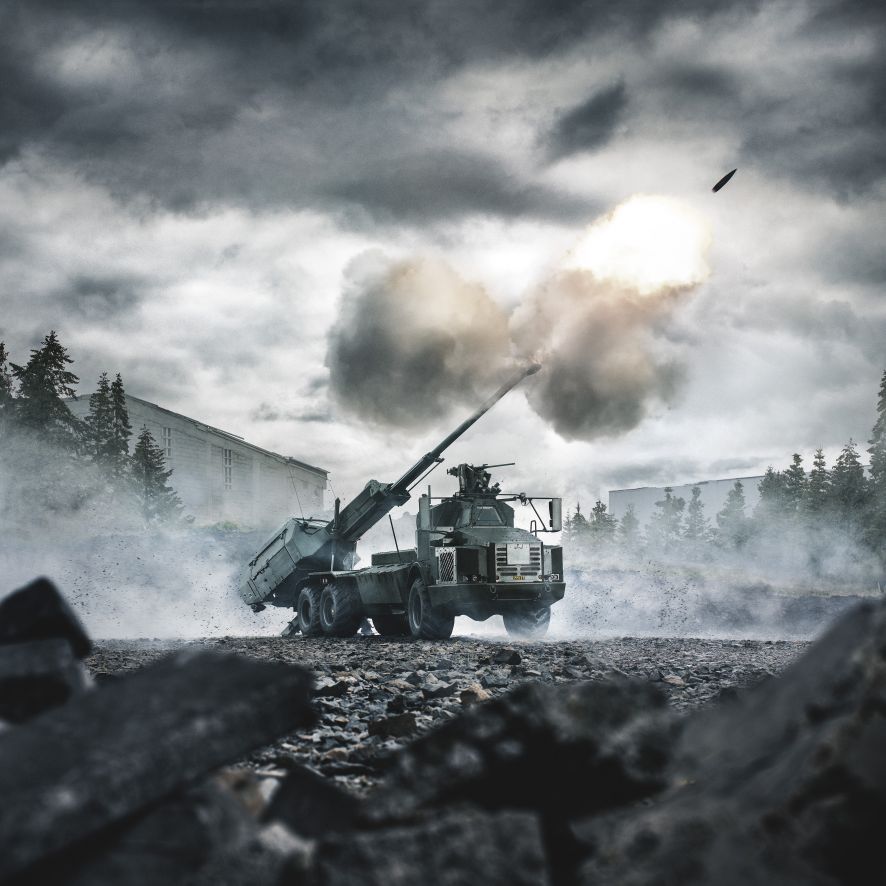
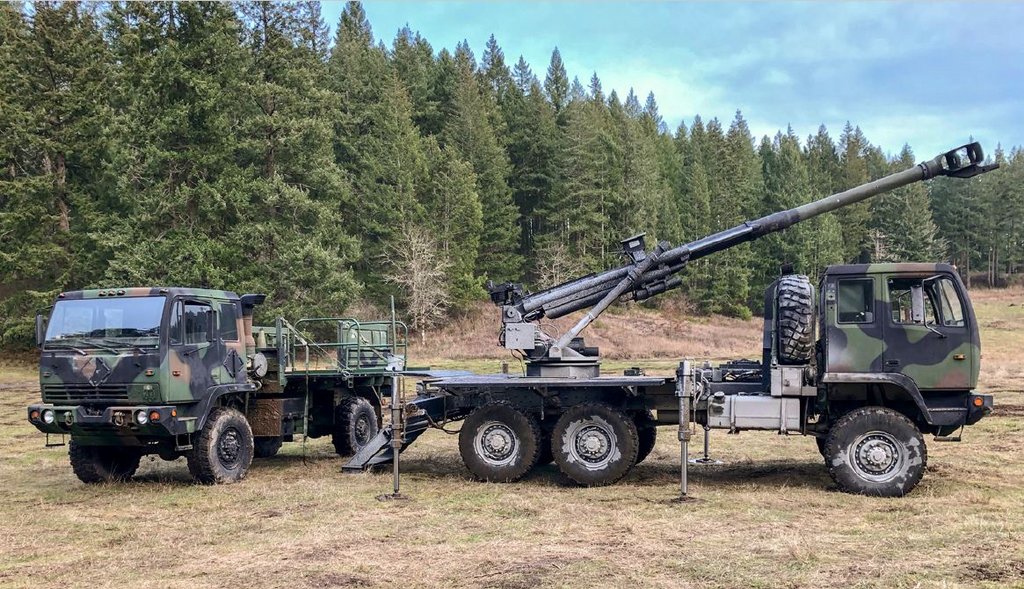
I think this latest news/contract award sort of confirms my suspicion. If Boeing is going to flight demo a scramjet cruise missile vehicle on a SH in 2022, then they've probably been working in parallel for some time now, either using IR&D or a US Navy classified award (which wouldn't be unusual since a number of technology maturation initiatives were underway over the last 3-5 years to explore if a Harpoon and TLAM replacement can be combined - Boeing could have picked up some hypersonic work from there). There is no way you can go from contract award to a flight demo in under 2 years if you're starting from scratch. Not for this level of tech.brar_w wrote:The USAF transition operational weapons program for DARPA's HAWC scramjet missile is casting a wider net when it comes to potential vendors. The Raytheon-Northrop team, and the Lockheed-Aerojet team (both of these teams already have built their DARPA missiles and are in pre-testing) will have to compete with Boeing. I wonder if Boeing hadn't, in parallel to DARPA's efforts, secured some classified scramjet work given they've been unusually quiet for nearly a decade following their X-51 scramjet efforts and successes. Would be unusual to seek a completely new OEM without any relevant recent experience when the timelines are to operationalize the system in a couple of years especially when the other two OEMs have a half a dozen or more tests already funded and lined up awaiting test resource and range availability.
USAF Names Three Bidders For Hypersonic Cruise Missile
A future hypersonic cruise missile will be competed between Boeing, Lockheed Martin and Raytheon, the U.S. Air Force has announced. The Aug. 5 selection revives Boeing’s role as a competitor for the Air Force's offensive hypersonic weapons...


Is Lockheed Martin building a secret new fighter jet that U.S. Air Force officials revealed last month?
Company executives dropped some not-so-subtle hints about the company’s growing backlog of classified military work, including one project that requires erecting a new building at its secretive Skunk Works facility in Palmdale, California. They also pointed to revenue growth within the company’s Aeronautics division, which includes the Advanced Development Programs shop that created the fabled U-2 and SR-71 spy planes and F-117 stealth attack jet.
“We do anticipate seeing strong double-digit growth at our Skunk Works — our classified Advanced Development Programs,” Lockheed CFO Ken Possenriede said during the company’s quarterly earnings call with Wall Street analysts. “We continue to execute on...recent awards.”
Last month, Air Force leaders revealed they had built and flown a prototype for the Next Generation Air Dominance program — an effort to develop a new generation of warplanes. Service officials said the project relied heavily on digital engineering, but declined to reveal much else, including what company or companies were working on the new aircraft. The classified aircraft project is believed to have started near the end of the Obama administration.
During an interview after the call, Possenriede mentioned a classified project that was the Aeronautics division’s top priority when he worked there between 2016 and 2019.
“It was bid aggressively [and] we happen to have won that one,” he said. “And we're very happy with the results [and] the outcome right now.”
On the earnings call, Possenriede said that “in the classified area of Aeronautics, there are a multitude of opportunities out there.”
He said the company needs to build a building for a classified project in Palmdale, adding that “There are other customers that have a keen interest in that program.”
In 2019, Lockheed’s Aeronautics division booked $19.6 billion in sales over the first nine months of 2020, that’s up nearly 13 percent higher than what the sector booked over the same period in 2019. Overall, the company will spend about $1.7 billion in capital expenditures, like new facilities, in 2020 and 2021, Possenriede said. As a while, the company will spend about $1.7 billion in capital expenditures, like new facilities, in 2020 and 2021, Possenriede said.
“We're going to keep investing in organic capital expenditures to build capacity to deliver on our core business,” Lockheed CEO Jim Taiclet said on the call. “Much of what we spent this year is on classified programs in both aeronautics and space, that are growing relatively rapidly. And so we're going to continue to do those organic investments every time we can.”
Aeronautics is not the only division seeing a bump in classified contracts. Lockheed’s Space and Missile and Fire Control divisions are also seeing an uptick in secret work.
The missiles division, which is working on hypersonic weapons projects with the Aeronautics and Space divisions, won what Possenriede called a “large classified program” that is still in development.
“We will start to see — in the next four to five years — that go into limited-rate production, and then ultimately into production,” he said.
The US Air Force is launching a program to acquire a new, highly flexible ground-attack munition to equip its combat aircraft. The service wants a Global Precision Attack Weapon, or GPAW, that would meet an ambitious set of characteristics: small, lightweight, and affordable in numbers, yet capable against hard and deeply buried targets, and with advanced sensors and autonomy.
The GPAW plan, unveiled in a Broad Agency Announcement on Oct. 19, calls for a weapon that would be carried internally on the fifth-generation F-35 fighter and B-21 bomber, but would still be compatible with legacy aircraft.
The weapon is to have “high loadout”—meaning many can be carried on a single platform, suggesting a small size—and digitally engineered, with open-systems architecture. It should enable “maximum flexibility to integrate a suite of technologies,” including position, navigation, and timing and guidance, navigation, control; as well as “cockpit-selectable warhead effect,” fuzing, sensors, propulsion, “signature optimization” or stealthiness, “martime apps, multimode seeker, affordable mass, and autonomy/sensing.”
GPAW will have to operate “within the joint, all-domain functional environment against near-peer competitors.” It was suggested the weapon should be able to collaborate autonomously. The announcement modified a previous announcement published by the Air Force and Special Operations Command in the spring.
The Air Force didn’t specify when it wants to have the weapon ready for use, but the announcement invites white paper responses from industry within a year. Contracts resulting from the solicitation are expected to be worth between $200,000 and $2 million.
The GPAW development program will be in three phases, and the Air Force will select and work with a System Design Agent to get the project started.
Phase 1: The government will characterize the “trade space” for the weapon, including what it can get within the cost and physical size limits it has in mind for GPAW. It will then set the open architecture standards, and develop a work breakdown structure and rough order of magnitude cost.
Phase II: A “best of breed” design will be developed along with various technical packages and a plan for rapid prototyping.
Phase III: The weapon will be competed for production, based on the technical data packages. The BAA suggested more than one manufacturer would be selected, with subsequent competition for lot buys.
The SDA and its partners “will not be excluded” from Phase II or III. “All businesses (small, medium, and large) are encouraged to submit white papers,” the service said.
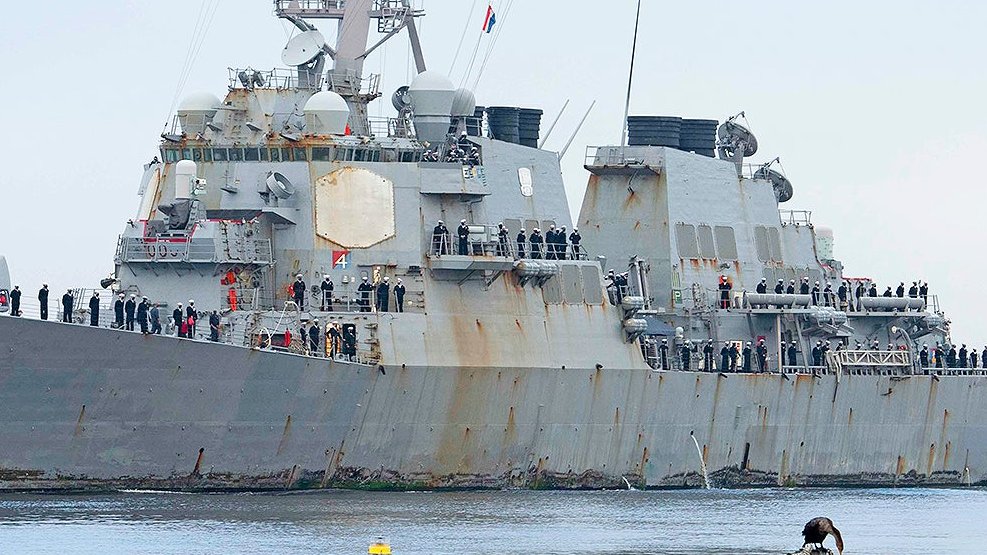
What would OpFires offer the Army it can’t get otherwise? It’s important that it’s both intermediate-range and hypersonic. In 2023, the Army plans to deploy both its first hypersonic missile, the Long-Range Hypersonic Weapon (LRHW), and its first intermediate-range missile since the Cold War Pershing III, the Mid-Range Capability (MRC). But it won’t have a weapon that’s both intermediate-range and hypersonic.
LRHW will be bigger, faster, and longer-ranged than MRC, flying “thousands of kilometers” as opposed to 1,800 km (1,118 miles). LRHW will also be much more expensive and relatively rare, reserved for the most important, distant, and difficult targets.
But just this year, the Army decided it needed MRC as well as a cheaper, more numerous weapon to strike larger numbers of less distant targets. That late start meant the Army couldn’t develop a new weapon by 2023, so it would need to modify a US or allied missile already in service – and none of those is hypersonic.
Having a smaller, cheaper hypersonic option alongside LRHW would be intriguing for Army commanders. “We view ourselves as complementary [to LRHW] and not duplicative,” Walker emphasized.
Significantly, Lockheed Martin has already selected the hypersonic glide body that will carry the missile warhead, coasting to the target (hence “glide body”) at Mach 5-plus once the rocket motors cut off. That glide body is the one Lockheed is already developing for the Air Force’s ARRW program (Air-launched Rapid Response Weapon). While the exact sizes of these weapons are classified, both DARPA and Lockheed Martin confirmed for me that the ARRW glide body is smaller than LRHW’s. That would allow the whole weapon to be smaller, which would make it cost less, too.
Why OpFires Would Be Revolutionary
OpFires isn’t just about building a smaller, cheaper hypersonic missile. If it were, DARPA wouldn’t bother, since the agency’s whole mission is high-risk, high-reward R&D. The “DARPA hard” part of the OpFires program is developing a revolutionary technology known as a “throttleable” rocket motor: In layman’s terms, a rocket that you can turn off at will, instead of having to wait until it burns through all its fuel.
You see, modern solid-fuel rocket motors have basically one setting: ALL AHEAD FULL. Once they’ve started burning and emitting thrust, you can’t turn them down or turn them off. (Liquid-fuel rockets don’t have this issue, but they pose other major problems in a military application). As a result, a solid-fuel rocket has trouble hitting targets that are significantly closer than its maximum range. You can make a long-range rocket hit a short-range target, but if you make it dive back towards the ground a lot earlier than it’s designed to do, that puts tremendous stress on the weapon, which could make it miss or even break apart in flight. That’s especially true for a rocket powerful enough to get the warhead moving at hypersonic speeds.
Simply put, Walker told me, “if you give it a lot of energy, it’s going to go far, and it’s actually really hard to make it go less far… without actually breaking it in the process.”
So instead of having a rocket motor you have to fight to rein in, you want a rocket motor you can just turn off when you’ve reached your target – a throttleable rocket. But that’s not easy either. For reasons of safety and reliability, solid rocket fuel is carefully formulated so it doesn’t either start or stop burning by accident, and historically no one tried to make it stop burning in mid-flight on purpose.
“Rocket motors are built to burn, and in this case, we’re trying to stop it when we want to,” Walker told me, “and, oh, by the way, also make it temperature-insensitive and safe for transport.” Army missiles in particular have to endure all sorts of conditions, from Arctic cold to desert heat to swampy humidity, and still fire reliably on command – and only when commanded to.
So in 2018, after a year of studies and consultation with the Army, DARPA contracted with three companies to develop throttleable rockets: Aerojet, Exquadrum, and Sierra Nevada Corporation (SNC). All three successfully demonstrated miniature versions of the motor and got further awards to build and ground-test a full-scale version. Exquadrum has completed that ground test, while Aerojet and SNC hope to do theirs before the end of the year. It’ll be up to Lockheed Martin, the prime contractor, to pick which of the three designs to use for the actual missile to be flight-tested in 2023.
A further wrinkle: The throttleable rocket motor will be the second stage of the OpFires rocket booster. The first stage launches the weapon and boosts it through the thickest part of the atmosphere, which requires different performance characteristics; it will be tested separately in November or December of next year.
Since the throttleable rocket motor is so tricky, DARPA and Lockheed Martin are trying to keep the rest of OpFires as simple as possible. Besides borrowing the ARRW program’s glide body, it’ll use the existing Army fire control system, AFATDS. It will require no new specialized support equipment; and its launcher will fit on the back of a common Army cargo truck, the 10-wheeler Palletized Load System (PLS). The weapon will fire from the back of the PLS in both the 2021 first-stage-only test and the 2023 full-up flight test.
What happens after that? TBD, Walker told me. DARPA’s job is to prove new technologies work, not to field them as integrated, combat-ready weapons systems: That’s the armed services’ job.
“A plan beyond 23? I can’t say that I have one today, but that’s clearly what we’re working to over the next year or two,” Walker told me. “In the ideal world, a service picks that up.”
The Navy might just be interested in OpFires as a lower-cost alternative to its own version of the long-range hypersonic weapon now that the White House wants to place hypersonics on all US destroyers. But DARPA’s big bet is on the Army.
LINK
The fresh coating of radar-absorbent material—the highly important outer cloak that helps the Nighthawk attenuate radar returns—apparently includes a bright red-and-black checkered tail-band. Notably absent is the 'Dark Knights' moniker seen on one F-117 spotted over the Mojave Desert in 2019. This is likely the unit's name, official or otherwise, that matches with the KNIGHT callsign they commonly use. High-contrast 'TR' tail markings are also present, indicating the aircraft's home base at Tonopah Test Range Airport. The F-117s carried similar tail markings decades ago after being declassified and before they moved from the remote Nevada base to Holloman Air Force Base in New Mexico.
The F-117 in the photos is also adorned with what appears to be a high-visibility Nighthawk emblem near its intake. The Nighthawk logo I am referring to looks like the one below and was used throughout the operational life of the program.
The shots come to us from Phil Decker who runs the Air Tales Instagram and Youtube accounts. They underline what The War Zone has been saying for some time, that the tiny flying F-117 force has migrated from a test and evaluation activity to also a more formal aggressor role. We may have even captured a photo opportunity at Tonopah Test Range Airport meant to commemorate the unit's establishment or another significant historical marker as a prelude to its first deployment. LINK
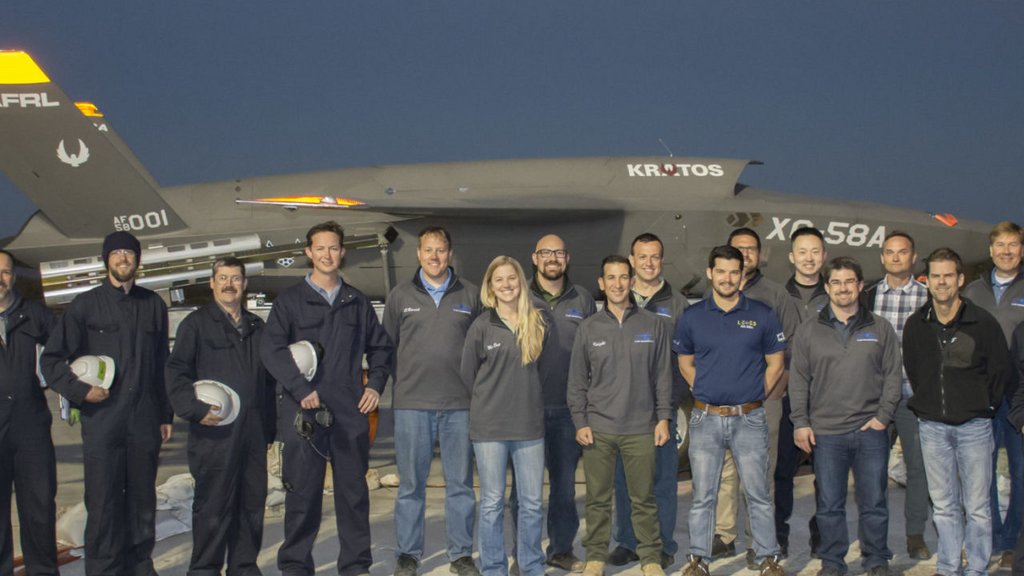
There are very stark differences in what the Ru Navy is doing and what the US Navy is doing in terms of outfitting its vessels with hypersonic missiles driven by the overall fleet architecture of these two forces, the threat they face and the theater they are optimizing themselves for. The USN's first stab is creating a nearly 4,000 km ranged Intermediate Ranged Conventional Prompt Strike capability that can outgun any A2AD the Chinese have in the pacific. Two guided tests have already happened and its striking targets within 6 inches based on the US Army's latest revelation (it is a joint USN and US Army program).Philip wrote:The USN plans to equip all its DDGs in the future right down to exg. Arleigh Burkes with hypersonic missiles to meet the threat from the PLAN. First Virginia class SSNs,then Zumwalt DDGs,then the Burkes in that order,since their missile silos are too small to take a larger " boost-glide" hyper M...
One hypersonic program that Bussey revealed is already in the works would eventually put a hypersonic cruise missile on a carrier-based F-18. She said the effort, which is being run by the Air Force Research Lab and has been contracted to Boeing, is developing a dual mode scramjet design. “We’re doing this so that we can have an option for the Navy that is compatible with F-18 based on carriers. We hope to have that testing wrapped up in time to support any decisions that either the Air Force or the Navy will end up making in terms of future hypersonic cruise missile activities.”
The U.S. Army has demonstrated the first prototype of a new laser weapon system based on the Stryker combat vehicle.
Video released by Army Professional Forum (APF) shows the finished, combat-capable prototype of the Directed Energy Maneuver Short Range Air Defense, or DE-MSHORAD, with a 50 kW-class laser integrated onto a Stryker platform.
Mounted on the newest Stryker A1 chassis, the DE-MSHORAD system, along with Interim Maneuver Short-Range Air Defense (IM-SHORAD) system, will be deployed to protect divisions and brigade combat teams from unmanned aerial systems (UAS), rotary-wing aircraft, and rocket, artillery and mortar threats.The new DE-MSHORAD capability will provide brigade combat teams with a 50-kilowatt laser aboard a Stryker combat vehicle in support of air defense artillery operations.
Currently, the force is working on fielding a DE-MSHORAD to the platoon level by fiscal 2022.
The Army also looks to field a 300-kilowatt Indirect Fire Protection Capability-High Energy Laser, or IFPC-HEL, and IFPC-High Powered Microwave, or HPM, at the platoon level in support of brigade air defense artillery operations in fiscal 2024.
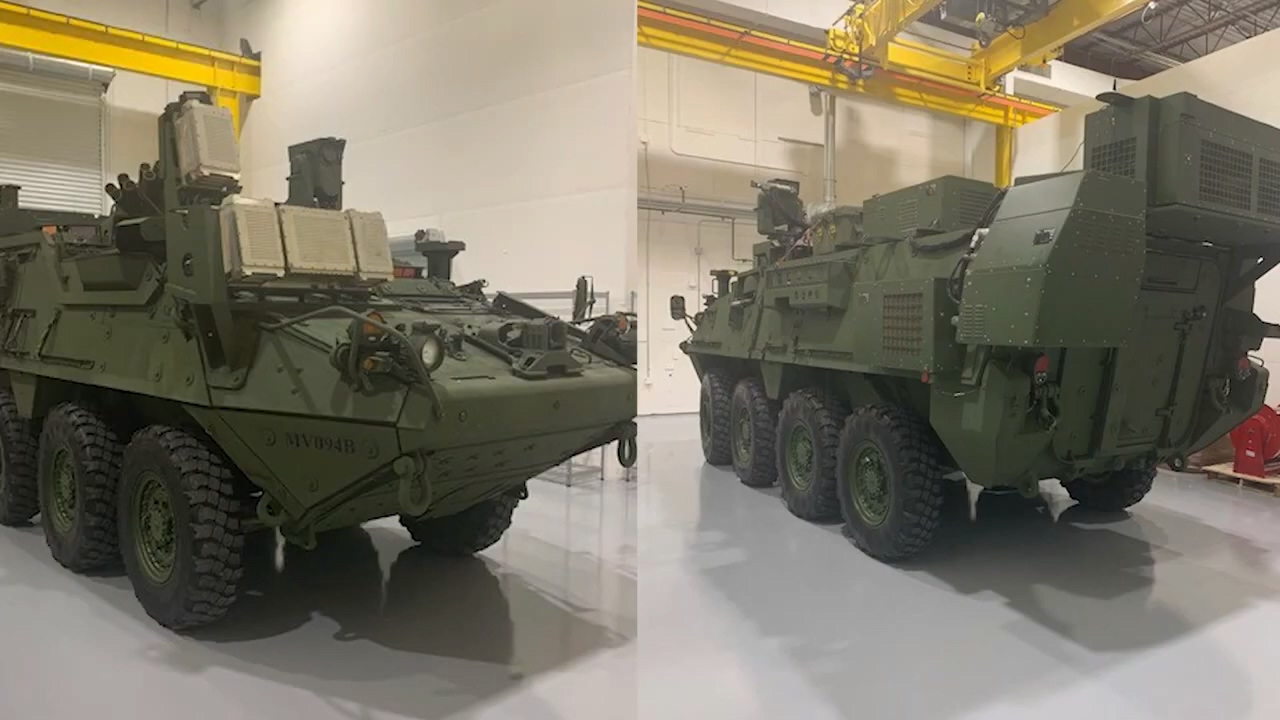
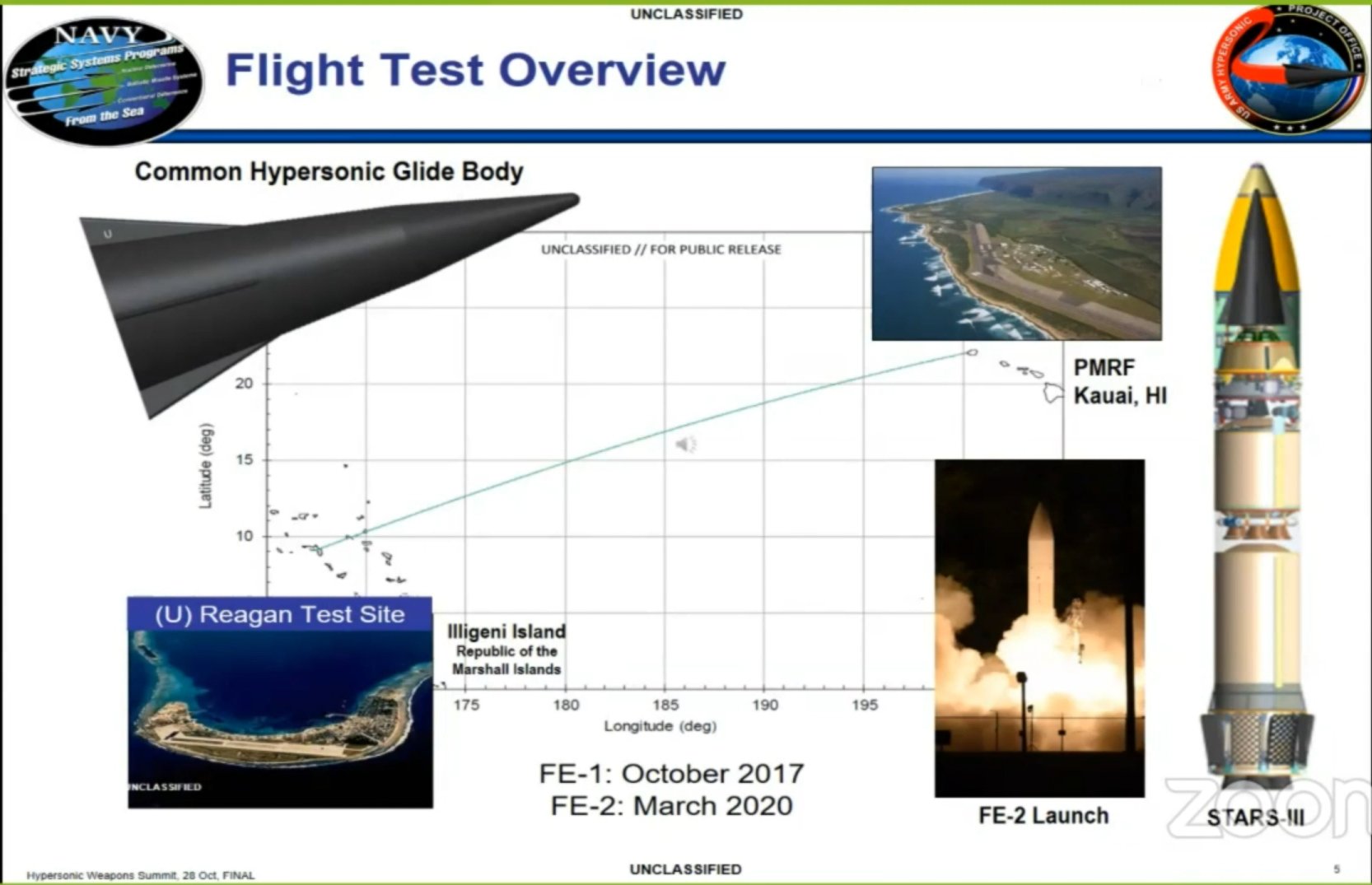
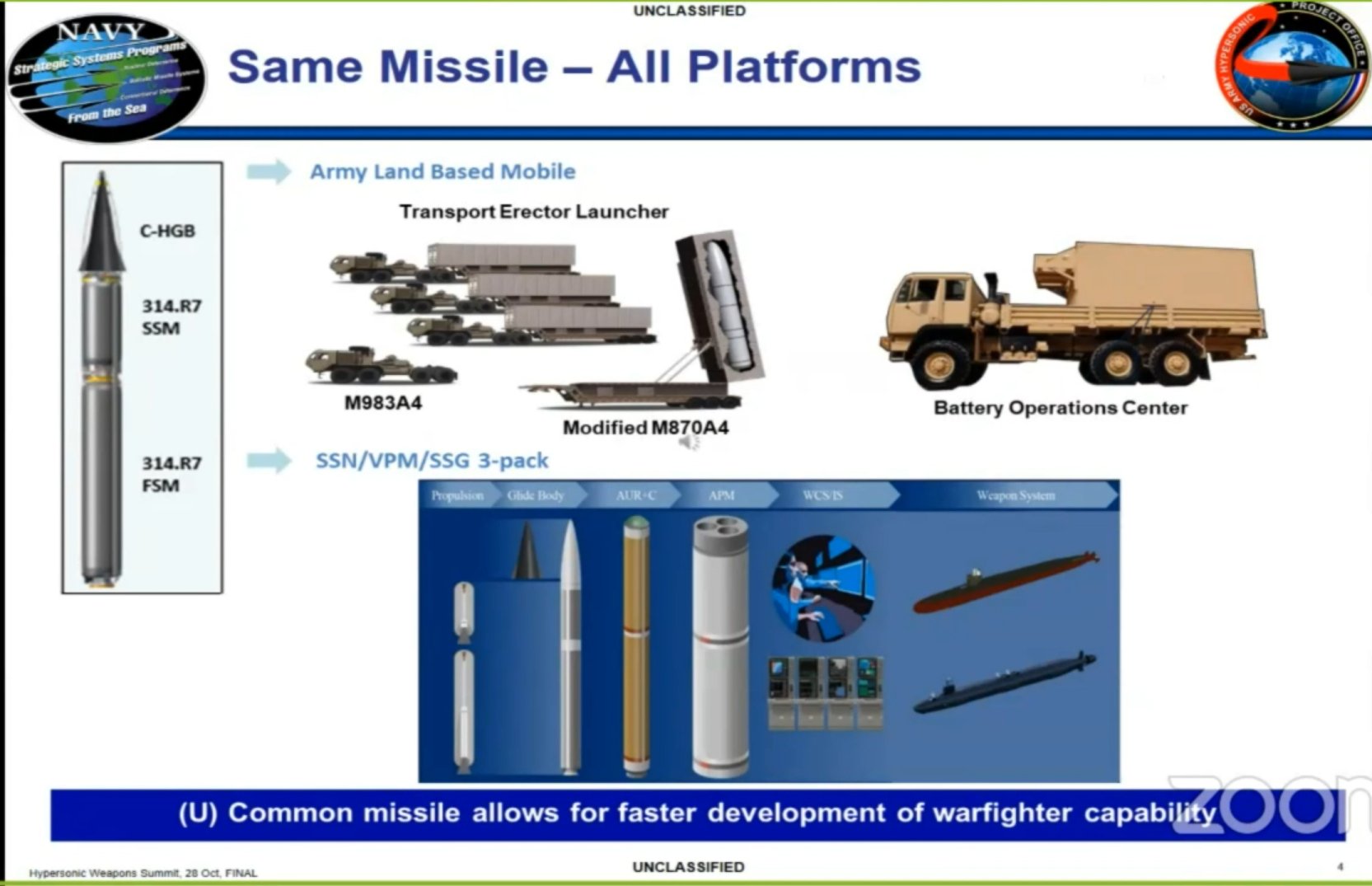
A formidable weapon which is practically screaming China as its target. America's very own answer to DF21. Infact range of this weapon(3800 kms) indicates that is designed to let US Navy ships stay out of reach of missiles like DF21. Induction of this weapon in decent numbers will ensure that Taiwan is safe for the foreseeable future.brar_w wrote:Some specifics on launch/target sites for the FE-2 tactical Hypersonic-BGV test conducted back in march. This puts the flight range at roughly 3,800 km so pretty safe to assume that the US Navy's and US Army's first operational conventional hypersonic weapon (IR-CPS and LRHW) will be in the 3,000+ km class.
Recently revelated test plans also highlight the amount of end to end testing they are going to be doing (or have done) prior to IOC and FOC. Without factoring in the pre 2017 boost glide testing this appears to be a 10 test shot campaign in support of the joint program. 2 FE level test events have already occurred, once in 2017 and one in March 2020. 3 more will follow next year, one in Mid 2021 and another two in Q42021. Following those, we will see at least 5 submarine launches in support of US Navy's IOC. Since the current and initial batches of BGV's are produced by Sandia and the rate-production BGV's will be produced by Dynetics corporation, that transition may warrant additional testing and qualification even though its licensed production. It'll be a busy program for the next few years as they plan on declaring IOC with the Army in 2023 time-frame, and with the SSGN fleet in 2025 with the latest block Virginia submarine fleet in 2028.
The 34.5 inch diameter LRHW & IR-CPS aren't Mk41 VLS compatible. They won't work on the DDG-1000's MK57 VLS either. For those you need a missile with a 22-24 inch diameter. There has been some talk of either a new larger diameter VLS or ripping the guns out of the DDG-1000 family and installing the VPM tubes in that space which would allow this missile to be carried by the three Zumwalt Class destroyers. Of course the next generation destroyer would have cells to carry larger than MK41 compatible missiles but that won't come online until the mid 2030's. Till then it will be mostly a submarine, and land delivered capability.darshhan wrote:
A formidable weapon which is practically screaming China as its target. America's very own answer to DF21. Infact range of this weapon(3800 kms) indicates that is designed to let US Navy ships stay out of reach of missiles like DF21. Induction of this weapon in decent numbers will ensure that Taiwan is safe for the foreseeable future.
However if biden is elected the next president expect this program to be significantly hampered. Chinese will never want this weapon to be deployed.
t. Venus Savage, MQ-25 assistant operational test director for VX-1 and MQ-25 air vehicle operator, participates in MQ-25 simulation training (photo courtesy of Boeing).
Naval Air Systems Command, Patuxent River, Md.
--
U.S. Navy aviators are already learning how to “fly” the MQ-25 unmanned aerial refueler before the first air vehicle comes off the production line.
Four Navy air vehicle operators (AVOs) from VX-23, the Navy’s developmental test squadron, and VX-1, the operational test squadron, recently traveled to Boeing’s St. Louis facility for an immersive three-day simulation designed to train them to operate a flight from start-up to shut-down from the ground control station (GCS) – the MQ-25’s terrestrial or CVN-based “cockpit.”
This course was possible due to the experience gained by flying T1, the Boeing-owned MQ-25 test asset developed prior to the Navy awarding Boeing the MQ-25 Engineering, Manufacturing and Development contract in August 2018. T1 first flew in September 2019 and to date has accumulated nearly 30 flight hours during its initial phase of testing. T1 recently underwent a planned modification to integrate an aerial refueling store (ARS) and is currently in ground testing prior to resuming flight testing. Navy AVOs will have the opportunity to serve in the co-pilot role, AVO No. 2, when flights resume.
Lt. Venus Savage, the VX-1 MQ-25 assistant operational test director, said the training was a unique opportunity to learn about the command and control processes used to interface with and operate the MQ-25 long before the first aircraft is delivered to the Navy.
“Especially for operational test, we’re lucky to be involved this early in the program,” Savage said. “It helps when you get that side information from an experienced AVO that adds to what’s in the documentation. We were able to ask detailed questions and get clarification on what the checklists and commands are and they let us know what to expect from the air vehicle. It helps ingrain it in your memory because it’s more than just book learning.”
The ongoing dialogue between Navy and Boeing AVOs helps shape the final system delivered to the Fleet, which is a win for the Navy, Boeing and ultimately the warfighters that will use the system.
Savage explained that the combined experience of the Navy and Boeing team differentiates MQ-25 from other programs. “While there are still changes to be made, like with all developmental programs, we’re working together to create a better finished product,” Savage said. “The collaboration is awesome. It’s a great team to work with.”
Yes and No. They are a specialized piece of equipment for very unique requirements. Take the LRHW program for example. The BGV will need to survive hypersonic cruise at as low as 40-50 km altitude for 1500 or more kilometers (assuming a 3K km range). Within that "cruise" phase it would need to execute very high G pull up manuevers, climb for 30-50 km and then skip and re-enter. And do this multiple times over its "cruise" phase. This is much more within atmospheric flight and G forces than a MaRV etc. The Common-BGV itself leverages the design and work done under the Sandia national labs's Winged Energetic Reentry Vehicle Experiment (Swerve) program which, back in the 1980's, was able to demonstrate a 10 degree AOA atmospheric pull-up at slightly more than Mach 12, followed by a 1.2 minute atmospheric flight at Mach 8.5. The within atmospheric flight requirements are multiple orders of magnitude higher than what SWERVE was able to demonstrate back then. Because this is a H-BGV application and they had to meet a Pre-INF demise requirement of >50% of flight range cruise within atmosphere (this is basically a self imposed requirement for all US H-BGV programs) they essentially needed to re-invent new TPS, internal electronics and newer guidance for it to be able to strike at better than current PGM level of accuracy (see the 6-inch official statement earlier up the thread) while also surviving the heat. I would say the Common HGV is at least 50% new with the baseline vehicle leveraging work already done under SWERVE before that program was terminated.Prasad wrote:Is it the case that these BGVs are shaped so (from the ground-up in a clean sheet design) due to the nuke stuff necessitating that shape or are they derived from current warheads modified to operate as glide vehicles?

